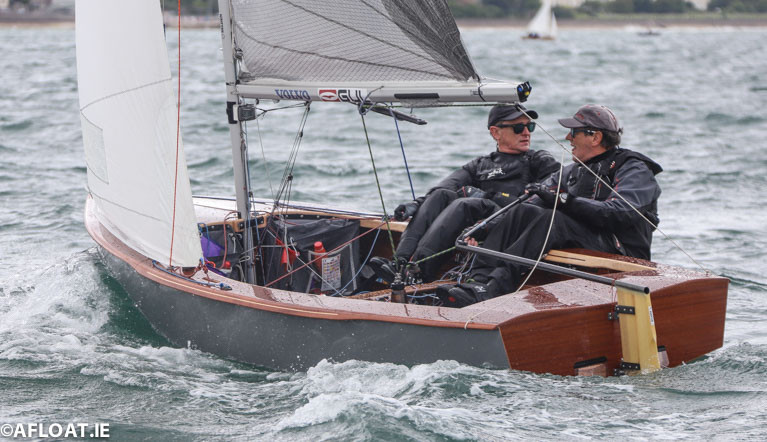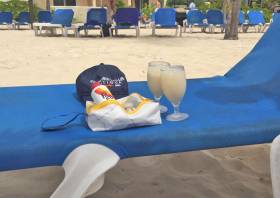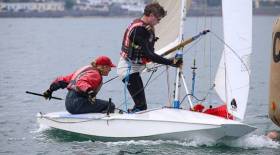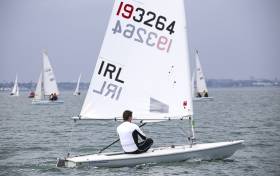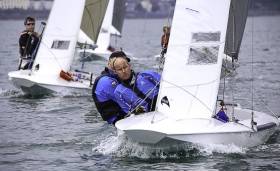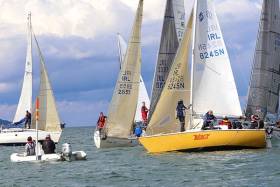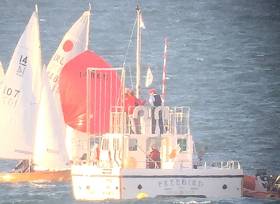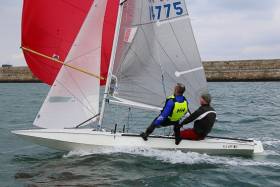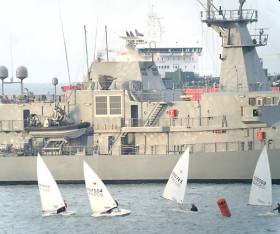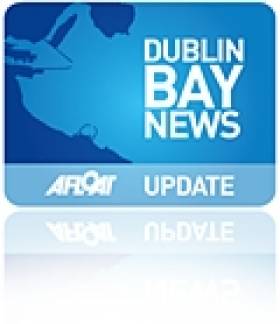Displaying items by tag: Dinghies
Adults Sail Dinghies Too
I learned my sailing crewing aboard a National 18 in Cork Harbour. That opportunity came through an adult sailing course because it was in my late 20s that I gained access to the sport.
Back then was not a time when getting into sailing was as easy as it is today. From crewing I bought a new Mirror dinghy and then a Vagabond, because it was the dominant dinghy fleet at the time in the club I joined - Monkstown Bay SC. At one stage there was a fleet of 30 of these 12ft. dinghies, which didn’t carry a spinnaker like the Mirror, but which was more attractive for me – because Vagabonds were raced by parents and their children. It was a great class. Fathers, mothers, sons, daughters, crewed for each other. The class had so many boats it qualified to have annual ‘national championships’ under then Irish Sailing Association regulations.
So adults sailed dinghies too!
But, gradually, ageing affected the Vagabond fleet, parents got older, younger and often better sailors took over in the natural evolution of things. The fleet continued to thrive until those youngsters moved on, getting jobs, moving away from the village and, gradually, the fleet died out.
Some of those young sailors went onto cruisers, others were lost to the sport, underlining a discussion which has followed my Podcast two weeks ago on the Irish Cruiser Racing Association’s Under 25 scheme, to encourage young sailors to get into cruisers as they come to an age when dinghies may no longer be their choice.
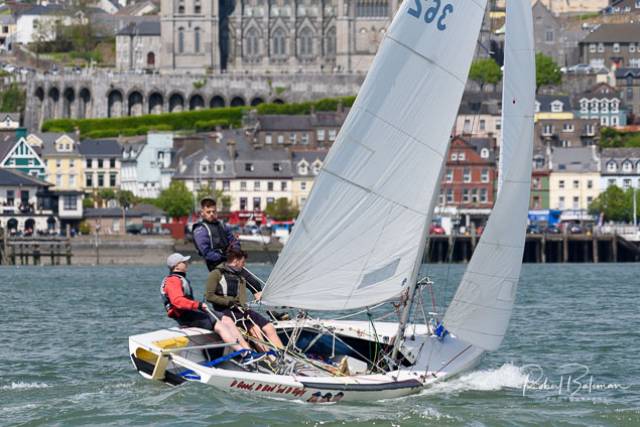 National 18 dinghy sailing in Cork Harbour Photo: Bob Bateman
National 18 dinghy sailing in Cork Harbour Photo: Bob Bateman
But, of course, there are adults who sail dinghies too. The National 18 fleet, where I learned to sail, is thriving in Cork Harbour. There are adults crews and fleets of Mermaids. Dublin Bay and Foynes are places I’ve reported about them. There are adult-crewed and active fleets of Wayfarers, Albacores, Lasers and others at various clubs and even, as has been pointed out to me, adults sailing Mirrors. Then there are other ‘open’ and ‘keel’ boats, the 1720s and 505s, Squibs and others, that are not cruisers, so there are other opportunities for young sailors to stay active in the sport.
"My underlying point is that adults sail dinghies too – so this is also an avenue for youngsters to remain in the sport …"
I was discussing this with Brian Raftery of ICRA whom I interviewed about the Under 25 cruiser racing programme to keep young people in sailing which he is leading. Listen to Brian Raftery here. He is a member of Sligo Yacht Club which has a very active GP fleet, a boat in which adults also sail in several clubs. “There are twenty GP14s in the dinghy park, 10-12 racing each week making up less than half of the club’s adult sailors. Nationally the GP is the biggest adult dinghy fleet in the country with about 40 boats at its National Championships every year,” he told me and added that the GP's have been successful in getting younger sailors into their fleet.
He said that he would “love to see someone take on the Under 25 area within dinghies.”
That is a good point. Why not?
As dinghy classes tend to operate somewhat in isolation in the sense of the various clubs where they are active, rather than the wider ambience of national cruiser organisation, it may be harder to develop a national/cross/class dinghy U25 approach.
My underlying point this week is that adults sail dinghies too – so this is also an avenue for youngsters to remain in the sport …
The important thing is to – KEEP ON SAILING.
• More on the Podcast below
Old Dinghy Sails Bag A New Life Thanks To Enterprising Amanda
A new business launched by a well-known sailor on the Water Wags scene uses upcycled sails to create quirky travel washbags.
Prisca Bags is the brainchild of Amanda Chambers, who repurposes old fabric from many different sources into a variety of bags for multiple uses.
One of the latest additions to her range using dinghy and spinnaker sail fabric, turned into “squashable, washable” travel bags.
Making the perfect gift for a spring getaway to a loved one — or yourself! — Prisca Bags are now available from the Dun Laoghaire Pharmacy on Upper George’s Street and other local retailers.
Viking Marine is among those congratulating Amanda, known for sailing the Water Wag Freddie as well as Spirit in the White Sails class, on her new ‘green’ venture.
The chandlery at The Pavilion in Dun Laoghaire is also putting out a shout for old dinghy and spinnaker sails as Amanda is working on upcycled props for the store.
Dublin Bay Sailing Club Results for 28 JUNE 2016
BENETEAU 31.7 - 1. Legally Blonde (C.Drohan/P.Egan)
CRUISERS 1 - 1. Jalapeno (P Barrington et al), 2. Powder Monkey (C Moore)
CRUISERS 3 Tuesday - 1. Pamafe (M Costello), 2. Isolde (B Mulqueen & J Martin), 3. Ventuno (R Fogarty)
FIREBALL Race 2- 1. Clandog Millionaire (C Clancy), 2. No Name (S Oram), 3. Goodness Gracious (Louise McKenna)
FIREBALL Race 1- 1. Incubus (C Power/M Barry), 2. Goodness Gracious (Louise McKenna), 3. No Name (S Oram)
GLEN - 1. Glendun (B.Denham et al), 2. Glenroan (T O'Sullivan), 3. Glenshane (P Hogan)
IDRA 14 FOOT Race 1- 1. Dunmoanin (Frank Hamilton), 2. Sapphire (Lorcan O'Sullivan), 3. Chaos (Pam McKay)
IDRA 14 FOOT Race 2- 1. Sapphire (Lorcan O'Sullivan), 2. Doody (J.Fitzgerald/J.Byrne), 3. Dunmoanin (Frank Hamilton)
Laser Race 1- 1. D Maloney (LDYC), 2. E Delap (DMYC), 3. John Marmelstein (RSGYC)
Laser Race 2- 1. D Maloney (LDYC), 2. E Delap (DMYC), 3. Gary O'Hare (RSGYC)
PY CLASS Race 1- 1. Richard Tate (), 2. Des Fortune (Finn)
RUFFIAN 23 - 1. Different Drummer (D Tonge), 2. Alias (D.Meeke/M.McCarthy), 3. Ruff Diamond (D.Byrne et al)
Dublin Bay Sailing Club Results for Tuesday, 21st June 2016
CRUISERS 1 - 1. Powder Monkey (C Moore), 2. Something Else (J.Hall et al), 3. Jalapeno (P Barrington et al)
CRUISERS 2 - 1. Bendemeer (L Casey & D Power)
CRUISERS 3 Tuesday - 1. Ventuno (R Fogarty), 2. Wynward (W McCormack), 3. Pamafe (M Costello)
FIREBALL Race 1- 1. No Name (S Oram), 2. Blind Squirrel (Frank Miller), 3. Goodness Gracious (Louise McKenna)
FIREBALL Race 2- 1. No Name (S Oram), 2. Blind Squirrel (Frank Miller), 3. Goodness Gracious (Louise McKenna)
GLEN - 1. Glendun (B.Denham et al), 2. Glenshane (P Hogan), 3. Glenroan (T O'Sullivan)
IDRA 14 FOOT Race 1- 1. Dunmoanin (Frank Hamilton), 2. Doody (J.Fitzgerald/J.Byrne)
IDRA 14 FOOT Race 2- 1. Dunmoanin (Frank Hamilton), 2. Doody (J.Fitzgerald/J.Byrne)
Laser Race 1- 1. E Delap (DMYC), 2. P Cahill (RSGYC), 3. Paul Keane (RIYC)
Laser Race 2- 1. Sean Craig (RSGYC), 2. Gary O'Hare (RSGYC), 3. Theo Lyttle (RSGYC)
PY CLASS Race 1- 1. Richard Tate (), 2. S Gordienok (Laser Vago), 3. P Ter Host (Laser Vago)
PY CLASS Race 2- 1. Richard Tate (), 2. S Gordienok (Laser Vago), 3. P Ter Host (Laser Vago)
RUFFIAN 23 - 1. Alias (D.Meeke/M.McCarthy), 2. Ruff Diamond (D.Byrne et al), 3. Ruff N Ready (Brian Uniacke)
Dublin Bay Sailing Club Results for 14 JUNE 2016
CRUISERS 3 Tuesday - 1. Papytoo (M Walsh/F Guilfoyle)
FIREBALL - 1. Clandog Millionaire (C Clancy), 2. Blind Squirrel (Frank Miller), 3. Licence to Thrill (Louis Smyth)
IDRA 14 FOOT - 1. Slipstream (Julie Ascoop), 2. Sapphire (Lorcan O'Sullivan), 3. Doody (J.Fitzgerald/J.Byrne)
Laser - 1. E Delap (DMYC), 2. D Maloney (LDYC), 3. C O'Leary ()
MERMAID - 1. Jill (P Smith/P Mangan), 2. Aideen (B.Martin/D.Brennan)
PY CLASS - 1. Richard Tate (), 2. Des Fortune (Finn)
Dublin Bay Sailing Club (DBSC) Results for Tuesday, 7th June 2016
CRUISERS 2 - 1. Borraine (D Butler), 2. Bendemeer (L Casey & D Power)
CRUISERS 3 Tuesday - 1. Pamafe (M Costello), 2. Asterix (Boushel/Meredith/Counihan), 3. Maranda (M Kelly)
FIREBALL - 1. Blind Squirrel (Frank Miller), 2. No Name (S Oram), 3. Goodness Gracious (Louise McKenna)
FIREBALL - 1. Clandog Millionaire (C Clancy), 2. No Name (S Oram), 3. Blind Squirrel (Frank Miller)
GLEN - 1. Glendun (B.Denham et al), 2. Glenroan (T O'Sullivan)
IDRA 14 FOOT Race 2- 1. Dart (Pierre Long), 2. Sapphire (Lorcan O'Sullivan), 3. Doody (J.Fitzgerald/J.Byrne)
IDRA 14 FOOT - 1. Doody (J.Fitzgerald/J.Byrne), 2. Dart (Pierre Long), 3. Sapphire (Lorcan O'Sullivan)
Laser - 1. Gary O'Hare (RSGYC), 2. John Marmelstein (RSGYC), 3. Ross O'Leary ()
Laser Race 2- 1. Ross O'Leary (), 2. John Marmelstein (RSGYC), 3. Michael McCormack ()
MERMAID - 1. Jill (P Smith/P Mangan), 2. Aideen (B.Martin/D.Brennan)
MERMAID Race 2- 1. Jill (P Smith/P Mangan), 2. Aideen (B.Martin/D.Brennan)
RUFFIAN 23 - 1. Alias (D.Meeke/M.McCarthy), 2. Different Drummer (D Tonge)
Dublin Bay Sailing Club (DBSC) Results for Tuesday, 31st MAY 2016
CRUISERS 2 - 1. Bendemeer (L Casey & D Power)
CRUISERS 3 Tuesday - 1. Grasshopper II (K & J Glynn), 2. Maranda (M Kelly), 3. Papytoo (M Walsh/F Guilfoyle)
FIREBALL Race 2- 1. Clandog Millionaire (C Clancy), 2. No Name (S Oram), 3. Blind Squirrel (Frank Miller)
FIREBALL Race 1- 1. No Name (S Oram), 2. Clandog Millionaire (C Clancy), 3. Licence to Thrill (Louis Smyth)
GLEN - 1. Glenariff (Adrian Lee), 2. Glendun (B.Denham et al), 3. Glenshane (P Hogan)
IDRA 14 FOOT Race 1- 1. Dunmoanin (Frank Hamilton), 2. Doody (J.Fitzgerald/J.Byrne), 3. Sapphire (Lorcan O'Sullivan)
IDRA 14 FOOT Race 2- 1. Dunmoanin (Frank Hamilton), 2. Sapphire (Lorcan O'Sullivan), 3. Doody (J.Fitzgerald/J.Byrne)
Laser Race 1- 1. D O'Connell (NYC), 2. Paul Keane (RIYC), 3. Sean Craig (RSGYC)
Laser Race 2- 1. D O'Connell (NYC), 2. Ross O'Leary (), 3. P Cahill (RSGYC)
MERMAID Race 2- 1. Jill (P Smith/P Mangan), 2. Aideen (B.Martin/D.Brennan)
MERMAID Race 1- 1. Jill (P Smith/P Mangan), 2. Aideen (B.Martin/D.Brennan)
PY CLASS Race 1- 1. Hugh Sheehy (OK Dinghy), 2. Richard Tate (), 3. S Gordienok (Laser Vago)
PY CLASS Race 2- 1. Richard Tate (), 2. Hugh Sheehy (OK Dinghy), 3. P Ter Host (Laser Vago)
RUFFIAN 23 - 1. Alias (D.Meeke/M.McCarthy), 2. Ruff Diamond (D.Byrne et al), 3. Different Drummer (D Tonge)
Dublin Bay Sailing Club (DBSC) Results for Tuesday, 24th MAY 2016
CRUISERS 3 Tuesday - 1. Wynward (W McCormack), 2. Capilano (S Soran), 3. Jiminy Cricket (M Tyndall)
FIREBALL - 1. No Name (S Oram), 2. Goodness Gracious (Louise McKenna), 3. Clandog Millionaire (C Clancy)
IDRA 14 FOOT - 1. Slipstream (Julie Ascoop), 2. Dart (Pierre Long), 3. Doody (J.Fitzgerald/J.Byrne)
Laser - 1. Paul Keane (RIYC), 2. E Delap (DMYC), 3. D Maloney (RSGYC)
PY CLASS - 1. Hugh Sheehy (OK Dinghy), 2. Tom Murphy (K1), 3. S Gordienok (Laser Vago)
RUFFIAN 23 - 1. Different Drummer (D Tonge), 2. Ruff Diamond (D.Byrne et al), 3. Ruff Justice (B Dobson)
Dublin Bay Sailing Club (DBSC) Results for Tuesday, 17 MAY 2016
BENETEAU 31.7 - 1. Legally Blonde (C.Drohan/P.Egan), 2. Kernach (Eoin O'Driscoll)
CRUISERS 3 Tuesday - 1. Pamafe (M Costello), 2. Jiminy Cricket (M Tyndall), 3. Maranda (M Kelly)
FIREBALL Race 2- 1. Clandog Millionaire (C Clancy), 2. No Name (S Oram), 3. Blind Squirrel (Frank Miller)
FIREBALL Race 1- 1. Clandog Millionaire (C Clancy), 2. Blind Squirrel (Frank Miller), 3. No Name (S Oram)
GLEN - 1. Glendun (B.Denham et al), 2. Glenariff (Adrian Lee), 3. Glencoe (Rose Mary Craig et al)
IDRA 14 FOOT Race 1- 1. Dart (Pierre Long), 2. Dunmoanin (Frank Hamilton), 3. Diane (B Murphy)
IDRA 14 FOOT Race 1- 1. Dunmoanin (Frank Hamilton), 2. Dart (Pierre Long), 3. Diane (B Murphy)
Laser Race 2- 1. Paul Keane (RIYC), 2. E Delap (DMYC), 3. P Cahill (RSGYC)
Laser Race 1- 1. Paul Keane (RIYC), 2. E Delap (DMYC), 3. P Cahill (RSGYC)
RUFFIAN 23 - 1. Different Drummer (D Tonge), 2. Alias (D.Meeke/M.McCarthy), 3. Ruff N Ready (Brian Uniacke)
Dun Laoghaire Dinghies Join INSS Sailors To Enjoy Challenging Conditions
#dbsc – At five minutes past one, the INSS Sailors competing in the DMYC Frostbites as part of the INSS Race Training Programme, were rigging their boats on the Coal Harbour Slipway, raring to go in a big breeze writes Kenneth Rumball. However it was not to be, the DMYC Frostbites race committee took the understandable decision that strong winds and swell from the Northerly wind in the harbour made attempting racing too difficult.
The trainees were disappointed, according to our race coach Alexander Rumball who was accompanying them in his RS400. So it was decided, Magnos and Laser IIs were put away in favour of Laser Picos with reefed sails. One of the Irish National Sailing Club members launched his Laser, accompanied by an INSS instructor in a school radial. With Alexander's RS400 included, there were the makings of a fleet large enough to get some racing done.
A triangle was set with the weather mark near the top of the West Pier, which according to the sailor's reports was a challenge to get around cleanly in the swell. On the start line we were joined by three more RS400's, a couple of Lasers and a Solo dinghy. The INSS support RIB acted as committee boat and two races were held. Unfortunately we aren't able to publish results as the Race Officer for the day doubled as safety boat driver and was called on to give a hand to a Laser which had dropped its rig during a capsize. While the rig was successfully put back up, the safety boat didn't quite make it back to be a committee boat in time to record the finishers.
No one seemed to mind though, everyone was just glad to be out on the water and enjoying the challenge the conditions posed. Our racing programme trainees were delighted with the chance to practice in stronger winds, and we were equally as happy to be able to provide the course, flags and a few horns so that the Dun Laoghaire dinghy sailors who braved the weather could join in too.


























